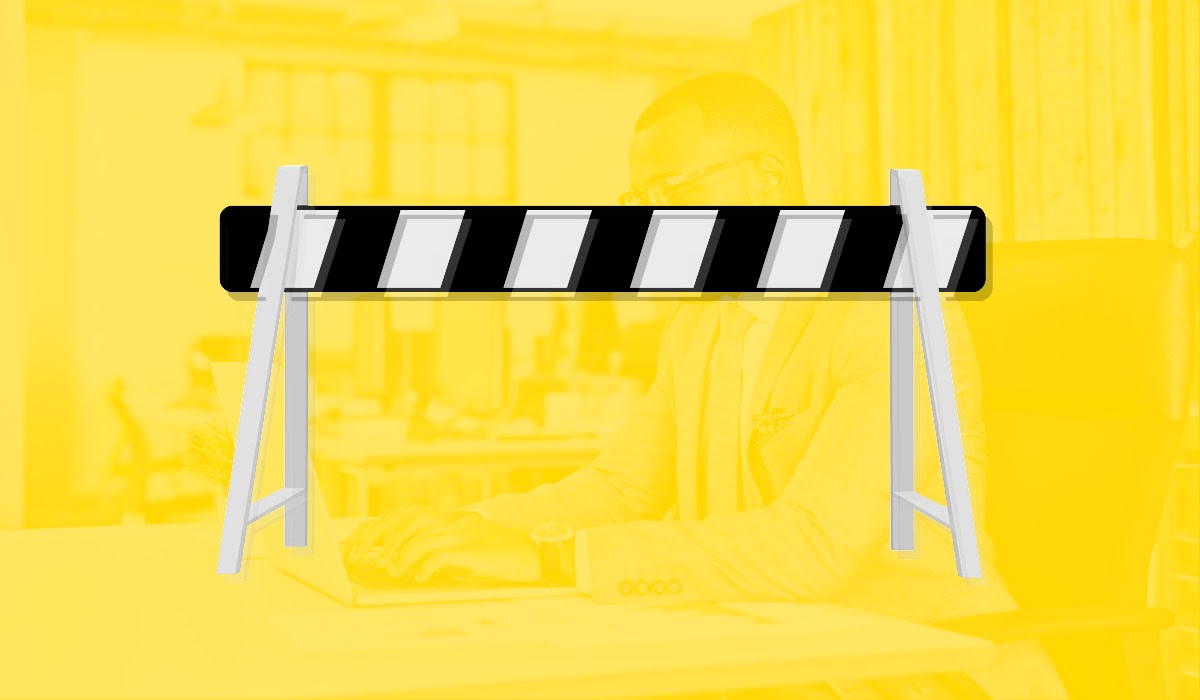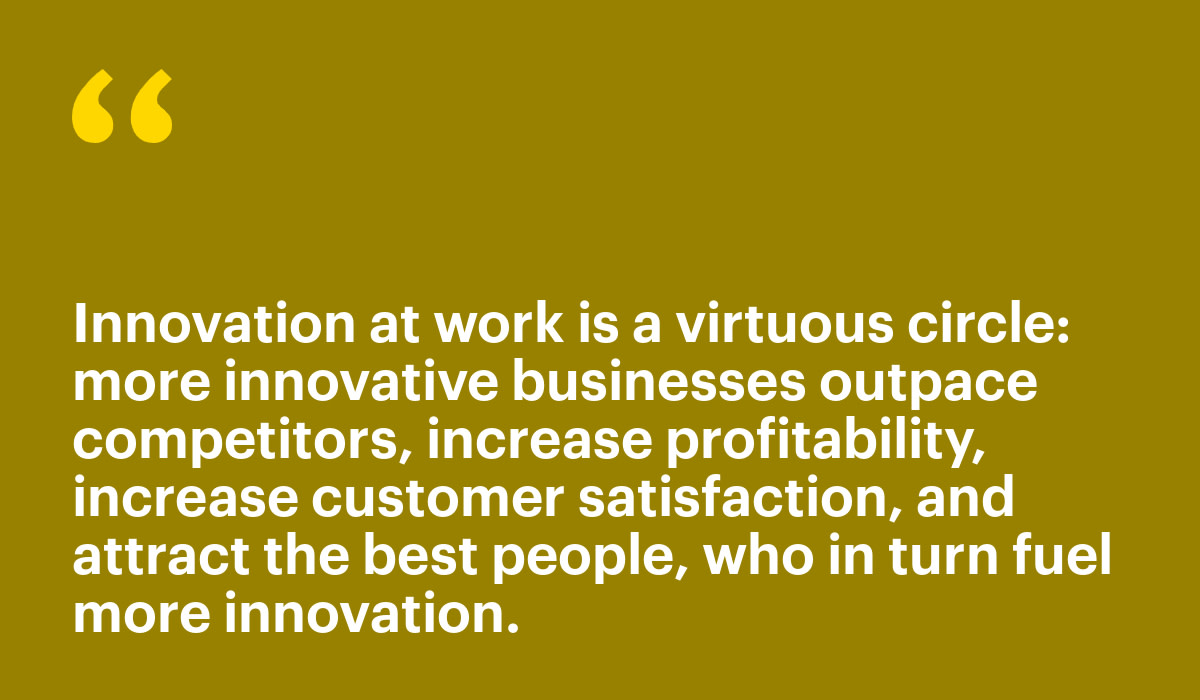5 Things Blocking Innovation in Your Workplace (and How to Fix Them)
What's blocking your innovation at work? Here are five common causes and how to solve for them.

Innovation—the implementation of new ideas, technologies, processes, products, or services—is essential to survival in today’s fast-paced business environment. The average age of an S&P 500 company is now under 20 years, down from 60 years in the 1950s: companies that don’t innovate don’t last long.
Innovation at work is a virtuous circle: more innovative businesses outpace competitors, increase profitability, increase customer satisfaction, and attract the best people, who in turn fuel more innovation.
It’s not surprising then that 84% of executives say innovation is extremely or very important to their growth strategy, McKinsey finds. It’s worrying, then, that only 6% of executives are satisfied with their innovation performance.
The blunt truth is, innovation at work is extraordinarily challenging. There are vast stumbling blocks throughout the innovation cycle, from absorbing great ideas at scale to prioritising and executing them.
Given these myriad factors, knowing how to improve your organisation’s innovation effectiveness can be difficult. But here’s another truth: like agility, innovation hinges on the workforce. Innovation at work is driven by employees at every level. People come up with ideas and either experiment, iterate and adopt or not.
Care about innovation? If you’re not laser-focussed on empowering your people leaders to act on your biggest workforce challenges, it’s not just HR outcomes that suffer. It’s your ability to innovate, hurting core business outcomes like profitability, revenue growth, and customer loyalty.
Here are five people problems that you might not realise hurt innovation—and how to empower your technology and innovation leaders to fix them.

1. High turnover
Replacing employees costs money, especially if they’re senior. Turnover costs directly impact the bottom line, so they’re on senior leaders’ radar. But—more insidious and longer-term—high turnover impacts the organisation’s ability to innovate.
When turnover contagion takes hold, losing more than your fair share of people disrupts business-as usual. Teams collaborate in different ways. Employees take on new tasks and pick up slack. Excessive turnover reduces collective bandwidth, so everyone’s stretched thinner. Burnout becomes a bigger threat (as if there wasn’t already a burnout epidemic).
An environment like that is hardly a breeding ground for creativity. Good ideas rarely come from disengaged, burnt out, overworked, stressed employees. Good ideas come from solid teams with a strong culture, where everyone’s firing on all cylinders.
That’s where people insights come in, equipping people leaders to identify root causes of turnover and take action to solve. Building a rock-solid culture allows innovation at work to flourish.
2. Lack of diversity and inclusion
Innovation at work means doing things differently. New ideas; new ways of working. You’ll struggle to achieve this without embracing differences in the workforce. Homogeneity, especially among senior strategic leaders (although good ideas can come from anywhere if you’ve built mechanisms to hear them), breeds homogeneity in how your organisation thinks and operates.
Is it any wonder innovation stalls when representation is unequal, especially at senior level? For instance, in 2020 Stanford Business analysed the Fortune 100 and found only 25% of total C-Suite positions were held by women, and only 16% were held by racially diverse executives. Only 7 of 100 had a female CEO, and 16 of 100 had a non-white CEO.
True innovation at work comes from a melting pot of diverse perspectives, challenging each other respectfully to push the boundaries and consider new ways of approaching problems.
This also touches on a related issue: inclusion. Even with equal representation up to board level (a laudable goal), diversity without an empowering culture of inclusion is tokenism—and tokenism doesn’t create a psychologically safe space where innovation can thrive.
Without diversity and inclusion, innovation at work will be stale at best. Or at worst, actively detrimental to diverse employee groups who weren’t properly considered during the process.
Progressing the DEI agenda is one of the major use cases for people insights, giving granular insights across the talent lifecycle to systematically hire, promote, engage, and keep talent from diverse backgrounds.
3. Skills shortages
Skills gaps are a profound issue in almost every industry. In the UK, for example, 88% of HR leaders say financial services is battling a skills crisis. This has obvious costs for business-as-usual, hurting productivity and disrupting delivery. The true extent of the problem might be hidden, as employees find workarounds and work overtime to deliver as best they can when they lack the right skills.
Highly skilled people are integral to innovation. Research shows that skills shortages induce the cancellation of innovation projects. Moreover, innovative firms are more likely to be subject to skills shortages to start with.
The impact of skills shortages on innovation at work is felt especially keenly at leadership level. Management and leadership skills are particularly important for innovation; strategic thinkers must astutely evaluate and choose different innovation strategies to stay remotely competitive in today’s landscape.
This is again where people insights can add huge value, not only illuminating current and future skills gaps but highlighting next steps to solve, whether that’s through reallocating, retraining, or recruiting.
4. Inefficient organisation design and workforce planning
Even a diverse, engaged workforce with the right skills isn’t a silver bullet for innovation. Organisation matters too. You might have great people on your payroll but unless they’re working on the right things, alongside the right colleagues, you’re using your human resource inefficiently.
In practice, that means your potential innovators don’t have exposure to the right parts of the business where they can add value. Poor workforce planning also locks up working capital—for example, paying contractors you don’t need—which tangibly hurts your ability to innovate.
People insights empower strategic workforce planning and organisation design, giving people leaders a data-driven, real-time picture of how work happens across your organisation so they can align talent to maximise your innovation capital.
5. Poor change management
Innovation at work might start with good ideas, but it succeeds and fails based on operational and tactical execution. Innovation creates the burden of change management for organisations (especially large ones.)
If you’re investing into new processes, systems, and technologies and asking people to work together in new ways, are you empowering them effectively to do so? Are you communicating effectively? Is your training effectively changing behaviour? Do you understand their new learning needs and meeting them? Are you actively monitoring and addressing on-the-ground challenges?
The stats suggest the answer, too often, is no. Only 15% of projects with poor change management met or exceeded objectives, to put that into context.
Taking control over the people side of change is critical to innovation project success. People insights are instrumental, for example, to identify resistance, analyse sentiment, guide implementation, and optimise training. As Change Management specialist Morten Kamp Andersen says, “Change management needs more data to assess risks, progress, adoption and usage and people analytics needs to apply its findings find more value. A partnership between the two functions will instantly add measurable value.”
Unblock innovation in the workplace with people insights
Innovation at work is a crucial business capability for organisations to survive and thrive for tomorrow, but incisive strategy and astute leadership alone aren’t enough.
Your people are the engine driving every initiative, every strategy, every tactic, every innovation. Innovation success means empowering leaders with the insights to understand, optimise, and empower teams continuously, at scale.
The bottom line? You need to really, really see your employees. Here’s how.


